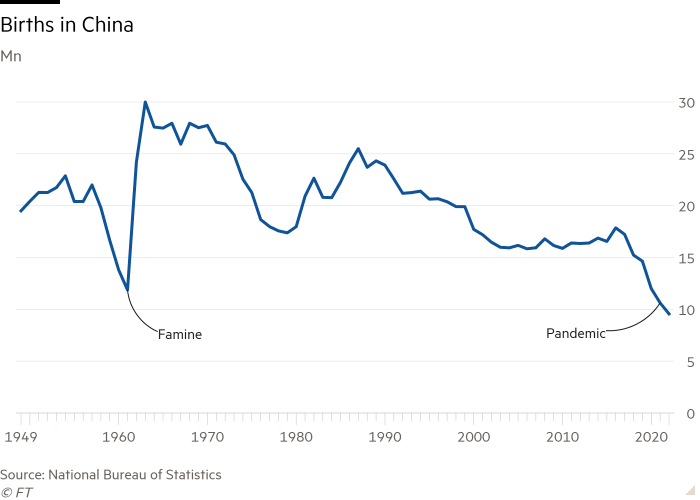China’s president Xi Jinping is poised to secure an unprecedented third term as leader at a congress of his Communist party this month, but behind the political theatre a broader shift is playing out.
Demographers predict the world’s most populous country will start to shrink in 2022, a turning point with profound ramifications for its future.
“That China’s population decline has coincided with the start of Xi’s third term is symbolically and practically significant,” said Wang Feng, an expert on Chinese demographic change at the University of California, Irvine.
While Xi is clearly in the political ascendancy, the economic tools at his disposal are increasingly constrained by a property sector meltdown, the damage to consumer confidence caused by successive coronavirus lockdowns, and local government fiscal shortfalls.
The rapid ageing of China’s population — a process that will accelerate during Xi’s third term — will further chip away at Beijing’s powers to stimulate growth and manage economic crises.
Over the next five years, the first cohort of people who became parents during the “one-child policy” era that began in 1980 will increasingly advance from their 60s and 70s — or what sociologists describe as being “young-old” — into their 80s.
Wang said this growing group of “old-old”, with a higher likelihood of developing costly chronic diseases, would make greater care demands both on their children and the state.
Local governments are already struggling to meet the rising cost of health and social care. Their spending on China’s sprawling zero-Covid infrastructure has ballooned, while tax receipts from the battered property sector have plummeted.
“If this continues, how can China sustain the pension payments for this enlarging elderly population,” said Wang.
Not all experts are pessimistic about the economic impact of the ageing population.
Jane Golley, a China economist at the Australian National University, said a shrinking number of working-age people was a natural consequence of the country’s economic development.
“A smaller workforce means reduced labour supply, which means workers can demand higher wages,” Golley said. Growth in gross domestic product per capita would outpace overall GDP expansion as China’s population shrank, she said.
But other experts warned that China could lose its cost advantage in manufacturing without having transitioned to the consumption-led economic model of developed economies.
China’s birth rate has been in decline for many years. Between the start of Xi’s rule in 2012 and 2021, the number of babies born each year fell by more than 45 per cent, to 10.6mn.

Beijing in 2016 eased national birth controls, which were widely known as the one-child policy in reference to the standard limit for urban residents of the dominant Han ethnic group. Local governments have since extended maternity leave and introduced subsidies for new parents.
China, which has the highest abortion rate among large economies, last year moved to tighten controls over abortions for non-medical purposes. Experts warned that officials could take more drastic measures to limit women’s access to abortion.
But Beijing’s measures to stimulate fertility have had little impact, particularly in the wake of the coronavirus pandemic and a strict zero-Covid policy that has disincentivised the young from getting married and having babies.
Yi Fuxian, an obstetrics expert at the University of Wisconsin-Madison and a long-term critic of the one-child policy, said rising unemployment and fear of persistent lockdowns have prompted young couples to delay marriage and childbearing. He estimated this would reduce the number of births in China by 1mn in both 2021 and 2022.
“The zero-Covid policy has greatly reduced people’s willingness to have children,” Yi said.
For a country’s population to remain stable, 2.1 children on average need to be born to each couple. Ms Li, a 34-year-old mother in the north-eastern province of Jilin, is one of the tens of millions of Chinese parents who have decided to stop at one.
Li, who declined to give her personal name, has a three-year-old and recently returned to part-time work selling tickets for local tourist attractions. “The expense of raising a child is like a bottomless pit,” said Li.
High property prices and heavy spending on education are major factors. In China, the average total cost of raising a child is nearly seven times per capita GDP, compared with four times in the US, according to YuWa Population Research, a Chinese think-tank.
Concerns about expensive childcare have been exacerbated by the economic insecurity wrought by lockdowns. Li’s hairdresser husband suffered a salary cut when his salon was forced to shut down during Jilin’s prolonged spring lockdown.
“One child is enough. We have no money or energy to raise a second,” she said.
Additional reporting by Xinning Liu in Beijing and Andy Lin in Hong Kong








